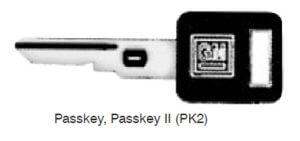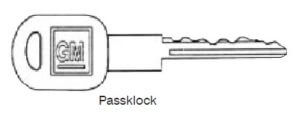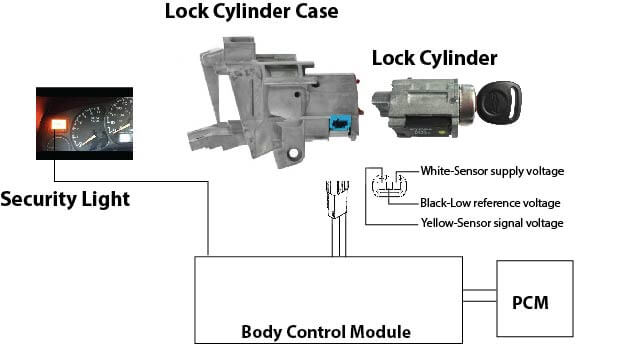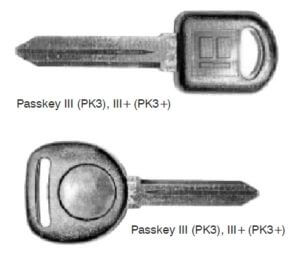PassKey versus PassLock
What’s the difference between Passkey versus Passlock on GM vehicles
The GM immobilizer systems have gone through several iterations. Most people want to know the difference between passkey versus passlock. Tt comes down to whether the system identifies the key or a unique identifier in the lock cylinder. Plus, GM changed the names of the systems based on where the decoding module is located. Here’s how they progressed
First Generation GM Immobilizer Vehicle Anti Theft System (VATS)
VATS uses a key with an embedded resistor chip/pellet. When you insert the key into the lock cylinder, electrical contacts from the Theft Deterrent Module (TDM) touch the resistor and measure its resistance. If the measured resistance equals the expected resistance, the TDM sends a signal to the PCM and the PCM allows engine start. If you replace the PCM, you do NOT have to do a PCM relearn because the TDM will still send a start/no start signal to the PCM. The PCM isn’t involved in reading the key pellet and determining whether it’s the correct key. If the vehicle doesn’t start, the problem is a bad key, bad electrical contacts or bad TDM. See the SECURITY light codes in this post to see what they mean
PassKey and PassKey I
PassKey works just like VATS. It relies on a resistor pellet and a TDM to  send a start/no start signal to the PCM. Just like the VATS system, if you replace the PCM, you do NOT have to do a PCM relearn because the TDM will still send a start/no start signal to the PCM.
send a start/no start signal to the PCM. Just like the VATS system, if you replace the PCM, you do NOT have to do a PCM relearn because the TDM will still send a start/no start signal to the PCM.
PassKey II works like a VATS and PassKey I BUT, the TDM is built into the body control module (BCM). The BCM sends a digital start/no start signal to the PCM over the data bus. This system does have a relearn procedure.
PassKey II Relearn Procedure
1. Turn the IGN switch to the ON/RUN position but don’t try to start the engine.
2. Leave the key in the ON/RUN position for approximately 11 minutes. The security light will be on steady on or flashing during the 11-minute period. WAIT until the SECURITY light STOPS FLASHING before moving to the next step.
3. Turn the ignition switch to the OFF position for 30 seconds.
4. Turn the ignition switch to the ON/RUN position for 11 minutes.
5. Turn the ignition switch to the OFF position for 30 seconds.
6. Turn the ignition switch to the ON/RUN position shown in Step 1 for 11 minutes. This will be the 3rd time you’re doing this.
7. Turn the ignition switch to the OFF position for 30 seconds for a third time.
8. Turn the ignition switch to the ON/RUN position for 30 seconds.
9. Turn the ignition switch to the OFF position.
10. Start the engine.
If the engine starts and runs, the relearn is complete.
What is the PassLock system?
The PassLock system is completely different than the PassKey system

PassLock Key has no resistor pellet or transponder
in that it uses an ordinary cut key. The guts of the system are located in the lock cylinder and lock cylinder case.
How PassLock works
The BCM is looking for a signal from the sensor in the lock cylinder case.

Passlock wiring diagram
You insert the proper key and rotate the lock cylinder. As the lock cylinder rotates, a magnet on the end of the cylinder passes by a sensor in the lock cylinder case. The sensor detects the presence of the magnet and notifies the BCM that the system is working properly. The BCM sends a start signal to the PCM over a data bus.
If a car thief yanks the lock cylinder, the sensor in the lock cylinder case detects the missing magnet and the BCM will send a NO START signal to the PCM. So car thieves can yank the lock cylinder and use a screwdriver to turn the IGN switch, but the vehicle won’t start. If they try to pass a magnet past the lock cylinder case after they’ve pulled the lock cylinder, it still won’t start because the BCM will already know the lock cylinder is missing.
The sensor in the lock cylinder case is a HIGH FAILURE RATE ITEM. When the system fails, it’s most likely due to a failed lock cylinder case sensor or a broken wire from the lock cylinder case to the BCM.
PassLock Relearn Procedure
Since the PassLock system can fail, you may have to perform the System Relearn to get the car started. But don’t kid yourself, this will NOT fix the underlying problem. You’ll still have to get the system repaired. See this post on how to diagnose and fix a PassLock system
Turn ignition switch to ON/RUN.
Try to start the engine, and release the key to the ON/RUN position.
Observe the SECURITY indicator light. After 10 minutes the SECURITY light will turn off.
Turn ignition to the OFF position, and wait 10 seconds.
Try to start the engine, and then release the key to the ON/RUN position.
Observe the SECURITY indicator light. After 10 minutes the SECURITY light will turn off.
Turn ignition to the OFF position, and wait 10 seconds.
Try to start the engine, and then release the key to the ON/RUN position.
Observe the SECURITY indicator light. After 10 minutes the SECURITY light will turn off.
Turn ignition to the OFF position, and wait 10 seconds.
Vehicle has now learned the new password. Start the engine.
With a scan tool, clear any trouble codes.
NOTE: For most cars, one 10-minute cycle will be enough for the vehicle to learn the new password. Perform all 3 cycles if the car will not start after 1 cycle. Most trucks will require all 3 cycles for learning the password.
PassKey III and PassKey III+
The PassKey III system uses a special key, but instead of relying on a

PassKey III and PassKey III+ Transponder Key
resistor pellet like the VATS and PassKey I and PassKey II system, this key has a transponder built into the key head.
A transceiver antenna is located in a loop around the lock cylinder. This “exciter” antenna energizes the transponder in the key head as the key moves closer to the lock cylinder. The key transponder sends a unique code to the antenna, which then communicates that code to the Theft Deterrent Control Module (TDCM). The TDCM then sends a start/no start command to the PCM over the data bus. The PCM then enables fuel.
The PassKey III system also has a relearn procedure, BUT once you activate the relearn, it will learn the key you’re using but will ERASE ALL OTHER KEYS THAT HAVE BEEN PREVIOUSLY PROGRAMMED INTO THE SYSTEM.
PassKey III Relearn Procedure
If you’re going to do a relearn, have ALL KEYS handy so you can program all of them at the same time.
Additional keys may be relearned immediately after the first key has been learned by inserting the additional key and turning the ignition switch to on within 10 seconds of removing the previously learned key.
1. Insert a master key (black head) into the ignition switch.
2. Turn key to the “ON” position without starting the engine. Security light should turn on and stay on.
3. Wait for 10 minutes or until the security light turns off.
4. Turn key to the “OFF” position for 5 seconds.
5. Turn key to the “ON” position without starting the engine. Security light should turn on and stay on.
6. Wait for 10 minutes or until the security light turns off.
7. Turn key to the “OFF” position for 5 seconds.
8. Turn key to the “ON” position without starting the engine. Security light should turn on and stay on.
9. Wait for 10 minutes or until the security light turns off.
10. Turn key to the “OFF” position. The key transponder information will be learned on the next start cycle.
11. Start the vehicle. If the vehicle starts and runs normally, the relearn is complete. If additional keys need to be relearned:
12. Turn the key to the “OFF” position.
13. Insert the next key to be learned. Turn the key to the “ON” position within 10 seconds of removing the previously used key.
14. Wait for security light to turn off. It should happen fairly quickly. You may not notice the lamp, as the transponder value will be learned immediately
15. Repeat steps 12 through 14 for any additional keys.
©, 2018 Rick Muscoplat
Posted on by Rick Muscoplat
